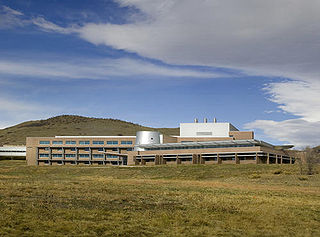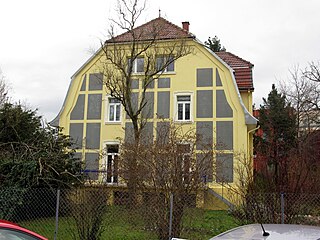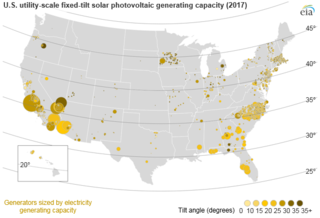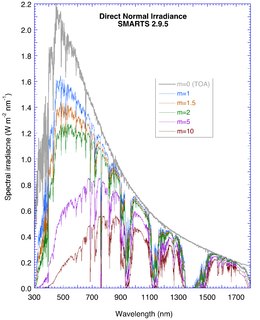Distributed generation, also distributed energy, on-site generation (OSG), or district/decentralized energy, is electrical generation and storage performed by a variety of small, grid-connected or distribution system-connected devices referred to as distributed energy resources (DER).

Denis Allen Hayes is an environmental advocate and an advocate for solar power. He rose to prominence in 1970 as the coordinator for the first Earth Day.

The National Renewable Energy Laboratory (NREL) in the US specializes in the research and development of renewable energy, energy efficiency, energy systems integration, and sustainable transportation. NREL is a federally funded research and development center sponsored by the Department of Energy and operated by the Alliance for Sustainable Energy, a joint venture between MRIGlobal and Battelle. Located in Golden, Colorado, NREL is home to the National Center for Photovoltaics, the National Bioenergy Center, and the National Wind Technology Center.

The International Solar Energy Society (ISES) is a non-profit UN-accredited membership NGO dedicated to the advancement of the utilization of solar energy and the transformation towards 100% renewable energy.

According to preliminary data from the US Energy Information Administration, renewable energy accounted for about 12.6% of total primary energy consumption and about 19.8% of the domestically produced electricity in the United States in 2020.
The American Solar Energy Society (ASES) is an association of solar professionals and advocates in the United States. Founded in 1954, ASES is dedicated to inspiring an era of energy innovation and speeding the transition toward a sustainable energy economy. The nonprofit advances education, research and policy.
Rebecca (Becky) Campbell-Howe is an American solar-energy editor and non-profit-organization administrator.

Solar power in the United States includes utility-scale solar power plants as well as local distributed generation, mostly from rooftop photovoltaics and increasingly from community solar arrays. From January through December 2021, utility-scale solar power generated 114.7 terawatt-hours (TWh), or 2.79% of all generated electrical energy in the United States. During the same time period total solar generation, including estimated small-scale photovoltaic generation, was 163.7 TWh.
Narec, since 2014 known as the National Renewable Energy Centre, is a part of the Offshore Renewable Energy (ORE) Catapult, a British technology innovation and research centre for offshore wind power, wave energy, tidal energy and low carbon technologies. ORE Catapult's head office is in Glasgow, Scotland. The centre operates multi-purpose offshore renewable energy test and demonstration facilities. It is similar to other centres, such as NREL in the US and National Centre for Renewable Energies (CENER) in Spain. The National Renewable Energy Centre is based in Blyth, Northumberland.
Arthur J. Nozik is a researcher at the National Renewable Energy Lab (NREL). He is also a professor at the University of Colorado, which is located in Boulder. He researches semiconductor quantum dots at the National Renewable Energy Laboratory, and is a chemistry professor at the University of Colorado. He also does research for the advancement of solar energy, for which he won the Intergovernmental Renewable Energy Organization (IREO) Award for Science and Technology in 2009.

Solar air heating is a solar thermal technology in which the energy from the sun, insolation, is captured by an absorbing medium and used to heat air. Solar air heating is a renewable energy heating technology used to heat or condition air for buildings or process heat applications. It is typically the most cost-effective out of all the solar technologies, especially in commercial and industrial applications, and it addresses the largest usage of building energy in heating climates, which is space heating and industrial process heating.
WREN is a major non-profit organization registered in the United Kingdom with charitable status and affiliated to UNESCO, the Deputy Director General of which is its honorary President. It has a Governing Council, an Executive Committee and a Director General. It maintains links with many United Nations, governmental and non-governmental organisations.

The Simple Model of the Atmospheric Radiative Transfer of Sunshine (SMARTS) is a computer program designed to evaluate the surface solar irradiance components in the shortwave spectrum under cloudless conditions. The program, written in FORTRAN, relies on simplifications of the equation of radiative transfer to allow extremely fast calculations of the surface irradiance. The irradiance components can be incident on a horizontal, a fixed-tilt or a 2-axis tracking surface. SMARTS can be used for example to evaluate the energy production of solar panels under variable atmospheric conditions. Many other applications are possible.

During the first decade of the new Millennium Italy was the third country after Germany and Spain to experience an unprecedented boom in solar installations after actively promoting solar power through government incentives. In July 2005 the country launched its first "Conto Energia" programme supporting the development of renewable power. Growth in solar installations picked up immediately but it was the years 2009-2013 that saw a boom in installed photovoltaic (PV) nameplate capacity, increasing nearly 15-fold, and 2012's year-end capacity of over 16 GW ranked second in the world after Germany, ahead of the other leading contenders, China, Japan and the United States at that time.

Solar power in Thailand is targeted to reach 6,000 MW by 2036. In 2013 installed photovoltaic capacity nearly doubled and reached 704 MW by the end of the year. At the end of 2015, with a total capacity of 2,500-2,800 MW, Thailand has more solar power capacity than all the rest of Southeast Asia combined.
Pauls Stradiņš Jr. is a physicist at the National Renewable Energy Laboratory in Golden, Colorado, and a foreign member of the Latvian Academy of Sciences.
Sarah R. Kurtz is an American materials scientist known for her research on solar energy and photovoltaics, including the application of multi-junction solar cells in robotic spacecraft. Formerly a research fellow at the National Center for Photovoltaics and principal scientist at the National Renewable Energy Laboratory, she is a professor of materials science and engineering at the University of California, Merced.
Jane H. Davidson is an American mechanical engineer whose research involves renewable energy, thermal energy storage, alternative fuel, and solar-powered carbon capture and storage for the energy needs of homes, workplaces, and vehicles. She is a professor of mechanical engineering at the University of Minnesota, where she directs the Solar Energy Laboratory, and is the former Ronald L. and Janet A. Christenson chair of renewable energy at the university.








